
|
| Sandstones are made of sand grains that have been cemented together. Like sandpaper, sandstones usually have a rough, granular texture, but to really identify a sandstone you have to peer closely at its surface and look for individual sand grains. Since the grain diameters range from 2 mm all the way down to only 0.06 mm, you may need a good magnifying lense to see the sand grains in a fine-grained sandstone. |
|
The grains are harder to see in the lower, rust-stained part of this rock. |
 |
|
The upper part of the rock shows faint horizontal layering, whereas the bottom shows faint crossbeds. |
 |
|
Geologists take a very close look because they learn young that it is easy to be fooled by the superficial appearance of a rock. Sandstones exposed near Etna, PA |
 |
|
Click to enlarge, and visit the Sedimentary Minerals page to see the super close-up. |
 |
|
Photo taken west of Pittsburgh (US 60). |
 |
Return to Image Archive Home Page
|
|
|